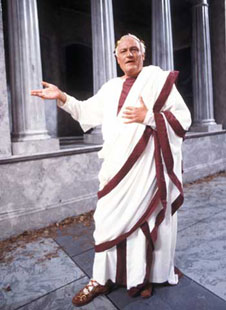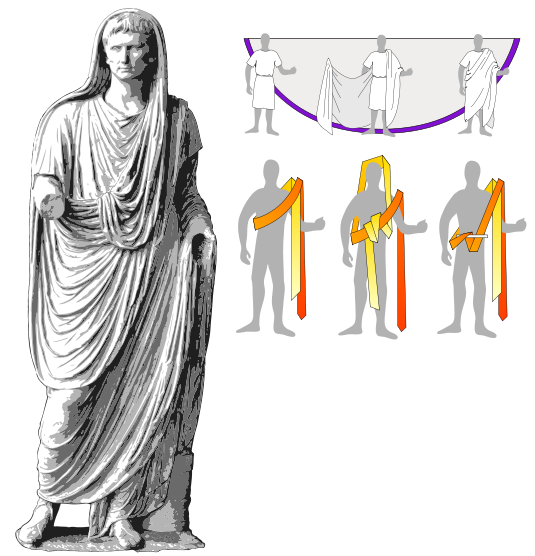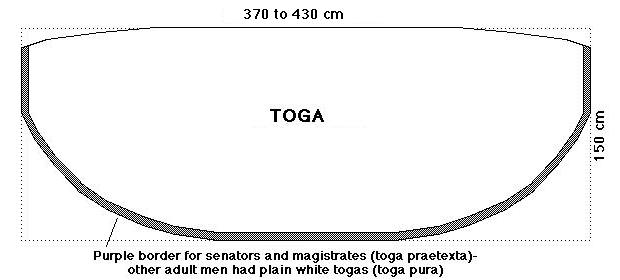Difference between revisions of "Toga"
(cleanup tag) |
|||
| (5 intermediate revisions by one other user not shown) | |||
| Line 1: | Line 1: | ||
| − | Roman men generally wore two garments, the [[tunica]] and the toga. The tunica was a short woolen under garment with short sleeves. By contrast, to wear a long tunic with long sleeves was considered effeminate and was generally avoided by society as a whole. It was originally worn mainly by the working class plebes, freedmen and slaves, though its function as an undergarment for any class of people is attested. | + | {{cleanup |
| + | |reason=no heading organization | ||
| + | |date=April 2016 | ||
| + | }} | ||
| + | |||
| + | [[Image:Togalife.jpg|frame|Toga praetexta worn by a reenactor]]Roman men generally wore two garments, the [[tunica]] and the toga. The tunica was a short woolen under garment with short sleeves. By contrast, to wear a long tunic with long sleeves was considered effeminate and was generally avoided by society as a whole. It was originally worn mainly by the working class plebes, freedmen and slaves, though its function as an undergarment for any class of people is attested. | ||
As the toga was specifically meant as a public display garment, the tunica was also worn by any people within the comforts of their own homes. The tunic worn by patrician men was made from white wool or expensive linen, while the poor would wear whatever fabric was readily available. Similar to the toga, distinct tunics were worn to signify one's title. Magistrates wore the tunic augusticlavia, and senators wore a tunic with broad strip called the tunica laticlavia. In addition, a belt would be worn around the waist of the tunica to hold the waist of the garment snug, giving the impression of a two piece garment. | As the toga was specifically meant as a public display garment, the tunica was also worn by any people within the comforts of their own homes. The tunic worn by patrician men was made from white wool or expensive linen, while the poor would wear whatever fabric was readily available. Similar to the toga, distinct tunics were worn to signify one's title. Magistrates wore the tunic augusticlavia, and senators wore a tunic with broad strip called the tunica laticlavia. In addition, a belt would be worn around the waist of the tunica to hold the waist of the garment snug, giving the impression of a two piece garment. | ||
| − | + | [[Image:535px-Roman toga diagram.svg.png|thumb|How to dress a toga]] | |
The classic toga was a distinct Roman garment that only actual citizens were allowed to wear. Its distinct purpose was to indicate peaceful endeavors, as opposed to the sagum cloak, worn during times of war. The toga was a large cumbersome robe like garment of white wool and used up to 9 yards of material. Being such a bulky and uncomfortable article of clothing, it became customary in later times to wear it only on state occasions. During the time of Augustus, however, he implemented a strict moral code requiring the toga to be worn in all facets of public life. As time passed and Roman societal tradition shifted and absorbed new cultures, these rules were relaxed. The more comfortable tunic, covered by a cloak called the lacerna, became commonplace in all facets of society. | The classic toga was a distinct Roman garment that only actual citizens were allowed to wear. Its distinct purpose was to indicate peaceful endeavors, as opposed to the sagum cloak, worn during times of war. The toga was a large cumbersome robe like garment of white wool and used up to 9 yards of material. Being such a bulky and uncomfortable article of clothing, it became customary in later times to wear it only on state occasions. During the time of Augustus, however, he implemented a strict moral code requiring the toga to be worn in all facets of public life. As time passed and Roman societal tradition shifted and absorbed new cultures, these rules were relaxed. The more comfortable tunic, covered by a cloak called the lacerna, became commonplace in all facets of society. | ||
| Line 10: | Line 15: | ||
''Toga praetexta'' was an off-white toga with a broad purple border. This toga was reserved for Senators and Curule Magistrates such as Consuls. There were minor distinctions between stripe indications for various magistrate positions. | ''Toga praetexta'' was an off-white toga with a broad purple border. This toga was reserved for Senators and Curule Magistrates such as Consuls. There were minor distinctions between stripe indications for various magistrate positions. | ||
| − | + | [[Image:Toga.jpg.jpeg|thumb|left]] | |
''Toga pulla'' was a dark toga worn strictly in times of mourning. | ''Toga pulla'' was a dark toga worn strictly in times of mourning. | ||
| Line 20: | Line 25: | ||
*[http://penelope.uchicago.edu/Thayer/E/Roman/Texts/secondary/SMIGRA*/Toga.html Good Toga site, directions and history] | *[http://penelope.uchicago.edu/Thayer/E/Roman/Texts/secondary/SMIGRA*/Toga.html Good Toga site, directions and history] | ||
| − | [[Category:Garb]] | + | [[Category:Garb]][[Category:Classical Garb]] [[Category:Men's Garb]] [[Category:Outerwear]] |
Latest revision as of 18:44, 3 April 2016
| This article may require cleanup. The specific problem is: no heading organization. Relevant discussion may be found on the talk page. Please help improve this article if you can. (April 2016) |
Roman men generally wore two garments, the tunica and the toga. The tunica was a short woolen under garment with short sleeves. By contrast, to wear a long tunic with long sleeves was considered effeminate and was generally avoided by society as a whole. It was originally worn mainly by the working class plebes, freedmen and slaves, though its function as an undergarment for any class of people is attested.
As the toga was specifically meant as a public display garment, the tunica was also worn by any people within the comforts of their own homes. The tunic worn by patrician men was made from white wool or expensive linen, while the poor would wear whatever fabric was readily available. Similar to the toga, distinct tunics were worn to signify one's title. Magistrates wore the tunic augusticlavia, and senators wore a tunic with broad strip called the tunica laticlavia. In addition, a belt would be worn around the waist of the tunica to hold the waist of the garment snug, giving the impression of a two piece garment.
The classic toga was a distinct Roman garment that only actual citizens were allowed to wear. Its distinct purpose was to indicate peaceful endeavors, as opposed to the sagum cloak, worn during times of war. The toga was a large cumbersome robe like garment of white wool and used up to 9 yards of material. Being such a bulky and uncomfortable article of clothing, it became customary in later times to wear it only on state occasions. During the time of Augustus, however, he implemented a strict moral code requiring the toga to be worn in all facets of public life. As time passed and Roman societal tradition shifted and absorbed new cultures, these rules were relaxed. The more comfortable tunic, covered by a cloak called the lacerna, became commonplace in all facets of society.
All togas were not the same and each distinctive type could mark a Roman's societal status or title. Some common, known types:
The toga virilis was a plain, unadorned toga made in off-white color. It was worn by any adult male.
Toga praetexta was an off-white toga with a broad purple border. This toga was reserved for Senators and Curule Magistrates such as Consuls. There were minor distinctions between stripe indications for various magistrate positions.
Toga pulla was a dark toga worn strictly in times of mourning.
Toga candida was an artificially whitened toga worn by candidates for political office. It was important to be white to indicate both purity of intention by the candidate and for the candidate himself to stand out from the crowd.
The toga picta was a special all purple toga embroidered with gold thread worn by a Roman general during a triumphal parade. Julius Caesar later adopted it as part of his regular dress and the emperors followed suit by using this type during many state occasions. The picta was likely adapted from the aptly named toga purpura, an all-purple toga worn by the early kings.


